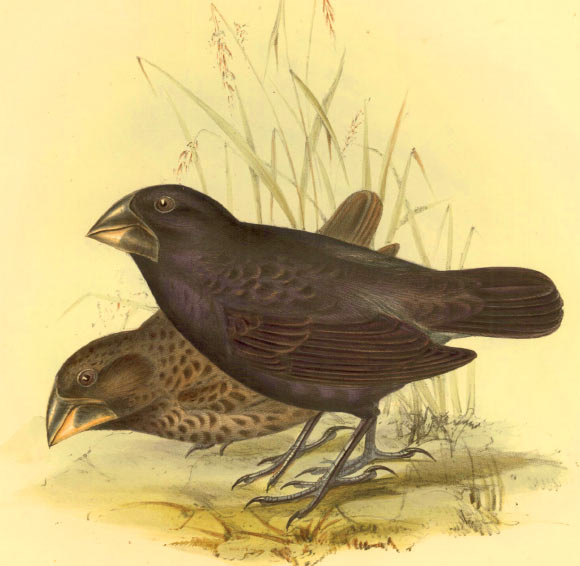Darwin’s finches, also known as the Galápagos finches, constitute an iconic model for studies of speciation and adaptive evolution. An international team of genetic scientists has now shed light on the evolutionary history of these birds and identified a gene that influences beak shape and played a role in the birds’ evolution from a common ancestor approximately one million years ago.

The large ground finch (Geospiza magnirostris), one of Darwin’s finches; Charles and Chatham Islands, Galapagos Archipelago. Image credit: © Linda Hall Library.
The study, published 11 February in the journal Nature, on the day before the 206th anniversary of the birth of Charles Darwin, illustrates the genetic foundation of evolution, including how genes can flow from one species to another, and how different versions of a gene within a species can contribute to the formation of new lineages.
Given the right conditions, such as isolation from the original population and an accumulation of genetic differences, these lineages can eventually evolve into entirely new species.
Working with DNA samples, the team led by Prof Leif Andersson from Uppsala University, the Swedish University of Agricultural Sciences and Texas A&M University identified the gene that influences beak shape by comparing the genomes of 120 birds, representing all of the Galápagos finch species and two close relatives.
“We have now sequenced 120 birds including all known species of Darwin’s finches, as well as two closely related species in order to study their evolutionary history,” said study first author Sangeet Lamichhaney, a PhD student at Uppsala University.
The scientists spotted a stretch of DNA that looked different in species with blunt beaks, such as the large ground finch (Geospiza magnirostris), versus species with pointed beaks, such as the large cactus finch (Geospiza conirostris).
Within that stretch of DNA, they found a gene known as ALX1, which has previously been identified in humans and mice as being associated with the formation of facial features. Mutations that inactivate this gene cause severe birth defects in humans.
“This is an interesting example where mild mutations in a gene that is critical for normal development leads to phenotypic evolution,” said Prof Andersson, who is the senior author of the Nature paper.
But the most exciting and interesting finding of the study was that ALX1 also varied among individuals from the same species.
For example, the medium ground finch (Geospiza fortis) species includes some birds with blunt beaks and others with pointed ones.
“This finding is significant because it shows how evolution can happen,” said co-author Prof Peter Grant of Princeton University.
Within a species, when some individuals have a trait that aids their survival – such as a blunt beak that allows them to crack open tough seed coverings – they will pass on the genes for that trait to their offspring, whereas individuals with pointed beaks will have died.
“This is the genetic variation upon which natural selection can work,” Prof Peter Grant said.
The study also adds to what is known about how genes are transferred from one species to another when individuals from two closely related species mate.
Although in many species of birds the resulting chicks would be sterile, the hybrid offspring of Galápagos finches can mate with an individual from either of the two parental species.
The resulting chicks will identify with one or the other of the parent species through song and appearance, but they will carry genes from both parents.
Through this process, known as gene flow, genetic material can move between species and contribute to the development of new species.
“During our field work on the Galapagos we have observed many examples of hybridization between species of Darwin’s finches but the long-term evolutionary effects of these hybridizations have been unknown,” said Prof Peter Grant and his wife, Dr Rosemary Grant of Princeton University, who is a co-author on the study.
“Now we can safely conclude that interspecies hybridization has played a critical role in the evolution of the finches, and has contributed to maintaining their genetic diversity,” Prof Peter Grant added.
_____
Sangeet Lamichhaney et al. Evolution of Darwin’s finches and their beaks revealed by genome sequencing. Nature, published online February 11, 2015; doi: 10.1038/nature14181







